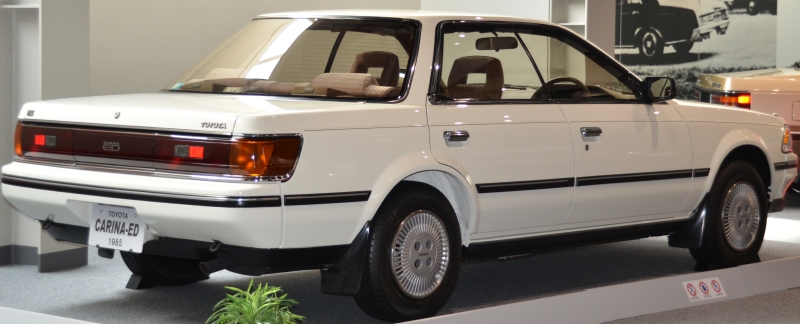Toyota Carina ED on:
[Wikipedia]
[Google]
[Amazon]
The Toyota Carina ED is a
 The hardtop approach was also used on the yet smaller Corolla/Sprinter platform, called the Corolla Ceres and the Sprinter Marino; these cars were offered for consumers who wanted the luxurious approach offered by the Toyota Crown hardtop and sedan, as well as the Mark II (four-door hardtop and sedan),
The hardtop approach was also used on the yet smaller Corolla/Sprinter platform, called the Corolla Ceres and the Sprinter Marino; these cars were offered for consumers who wanted the luxurious approach offered by the Toyota Crown hardtop and sedan, as well as the Mark II (four-door hardtop and sedan),
File:Toyota carinaed st200 1.8x 1 r.jpg, Toyota Carina ED (pre-facelift, Japan)
File:Toyota carinaed st202 xexcitingversion 1 f (cropped).jpg, Toyota Carina ED (facelift, Japan)
File:3rd generation Toyota Carina ED rear.jpg, Toyota Carina ED (facelift, Japan)
Carina ED(First)
- Toyota Official Website
Carina ED(Second)
Carina ED(Third)
{{Toyota Motor Corporation Carina ED Cars introduced in 1985 Front-wheel-drive vehicles All-wheel-drive vehicles Vehicles with four-wheel steering
compact car
Compact car is a vehicle size class — predominantly used in North America — that sits between subcompact cars and mid-size cars. "Small family car" is a British term and a part of the C-segment in the European car classification. However ...
manufactured by Japanese automaker Toyota in 1985 as a companion to the 1984 Carina sedan. It was positioned as the four-door Celica, with a similar focus on luxury found on larger Toyota hardtop sedans, like the Toyota Crown and the Toyota Cresta. It was the counterpart of the Corona EXiV. Its design sought to emulate the hardtop four-door coupé styling of large American and European sedans, resulting in a small, low cabin with longer front and rear ends. The ED's B-pillar stood up in the middle with no purpose other than to hinge the rear door on; it was not attached to the roof side of the cabin. The ED achieved huge sales in Japan, and other Japanese manufacturers introduced the Mazda Persona, Nissan Presea
The is a compact car, produced for the Asian market from 1990 to 2000. It competed with the entry level luxury 4-door hardtop sedans that were popular in Japan during the 1990s, notably the Toyota Corolla Ceres, the Toyota Sprinter Marino, the ...
, and Mitsubishi Emeraude around the same time. "ED" is the initials of "Exciting" and "Dressy". When the Carina ED was discontinued, the Toyota Brevis appeared for the market segment served by the Carina ED.
__TOC__
First generation (ST160; 1985)
The first generation was a new design direction, emphasizing styling and comfort over practicality and economy. The Carina ED was introduced in May 1985. The Celica platform was used and attention was placed on handling and performance. The initial lineup offered two 1.8-litre engines and one twin cam 16-valve 2.0. The 1S-iLU had single-point injection while the 1S-ELU used multi-point injection, as did the top of the line 3S-GELU. Power outputs were initially in JIS Gross, and the three engines were rated at . With the later net rating, power figures drop down to respectively. Fog lamps were made standard August 1987, and the 1S-ELU engine was replaced by the 2.0-litre 3S-FE, producing JIS net. In May 1988 the 1S-iLU was replaced by the 1.8-litre 4S-Fi, with JIS net; this meant that the engine lineup now consisted entirely twin cams. When the first Carina was introduced in 1970, it was identified as a four-door Celica, but sold at a different Toyota Japan dealership called '' Toyota Store'' as a Corona-sized sedan with the performance-enhanced image of the Celica. The Corona was exclusive to ''Toyopet Store'', and the Celica was exclusive to ''Toyota Corolla Store''. The introduction of the Carina ED represented a reintroduction of the performance reputation of the Celica, once again as a four-door version.Cresta
Cresta may refer to:
* Cresta, Gauteng, a suburb in South Africa
* CRESTA, Catastrophe Risk Evaluating and Standardizing Target Accumulations
* Cresta Awards, international advertising awards
* Cresta (soft drink)
* Vauxhall Cresta, an automobi ...
(4-door sedan) and Chaser (four-door hardtop) but at a lower price and reduced tax liability based on the vehicles size and engine displacement.
Second generation (ST180; 1989)
The restyled second generation was introduced 1989 and luxury equipment content increased. Four-wheel steering appeared on the top level offerings and styling was updated more closely resemble the twin introduction of the Toyota Corona EXiV, and shared it appearance with the Toyota Corona and Toyota Carina. Along with some minor changes in August 1988, electronic fuel injection was made standard on all engines offered as the 4S-FE replaced the 4S-Fi. The output of the lesser, narrow-valve 2.0-litre 3S-FE was also increased at the same time, from . This generation was the last true hardtop as the next generation had a complete B-pillar extending all the way to the roof.Third generation (ST200; 1993)
The four wheel drive system introduced on this generation was borrowed from the Toyota Celica GT-Four. Four wheel steering was available. The trim level designations were 1800V, 2000X, 2000GT and 2000GT-4WD. As a result of styling changes, sales improved in comparison to the second generation. A driver side airbag appeared September 1995, as well as speed sensitive door locks and climate control air conditioning. A passenger side airbag appeared June 1996. Production ended due to economic conditions April 1998.References
External links
Carina ED(First)
- Toyota Official Website
Carina ED(Second)
Carina ED(Third)
{{Toyota Motor Corporation Carina ED Cars introduced in 1985 Front-wheel-drive vehicles All-wheel-drive vehicles Vehicles with four-wheel steering